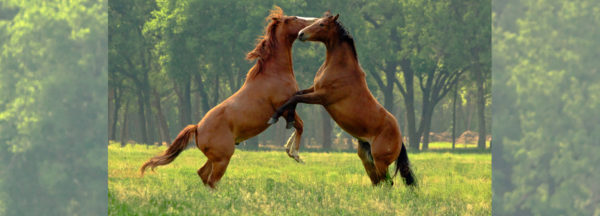Training Tip: Horse Terrorizes Other Horses in Turnout

Question: Our rescue currently has 16 horses on site that live in paddocks in groups of twos and threes. Thomas lives alone because he doesn’t get along with other horses. He is a 15-year-old Percheron mix gelding, about 16 hands. Here is what happens when we try turning him out with a new potential pasture mate: He is brought into the other horse’s paddock (or the new horse is brought to him, we’ve tried both ways). They introduce themselves normally, and Thomas is curious and amiable for about the first 10 to 20 minutes. Then, all of a sudden, it’s like someone flips a switch and Thomas turns into a mean bugger. I’m not talking about the usual establishment of pecking order and dominance displays that might look a bit ugly from a human perspective. He absolutely terrorizes the other horse. He ends up chasing the poor thing around the paddock and won’t relent. Once we separate them, the other horse is sweating and shaking and terrified, sometimes injured if we don’t intervene quickly enough. We have tried this with several horses of different temperaments, sizes and personalities. Same story every time. I can’t help wondering if we are doing something wrong, or if we need to try another approach with Thomas. – Sarah Krahn
Clinton’s Answer: Some horses are just jerks to other horses, and it sounds like Thomas fits that bill. Horses each have their own personalities just as people do. Some people are pleasant and can get along with anyone and others hate the world and are big bullies.
Your options are to either continue to turn Thomas out in a pasture by himself or turn him out with other horses using sideline hobbles. If I know that one of the horses in my herd is a very dominant individual and the chances of him harming the other horses are high, I hobble the aggressive horse. A sideline hobble attaches to one of the horse’s back feet and his front foot on the same side of his body. The effect is that the horse can still move around but not easily.
It’d be kind of like tying someone’s shoelaces together. Sure, you can still move around, but you’re not going anywhere fast. That stops the horse from running the other horses around the pasture and makes it impossible for him to kick and strike.
Every 24 hours, change what side of the horse’s body the sideline hobble is on. So one day leave it on the left side, and the next day put it on the right side.
In some cases, where I’m dealing with an especially assertive broodmare, I’ll sideline her for two or three weeks until the other horses become accustomed to her and she becomes accustomed to them. Then I can take the sideline off and they all get along without an issue. That’s something you could try with Thomas as well.
